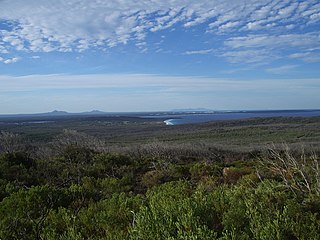
The Koreng, also spelled Goreng, are an indigenous Noongar people of south-west of Western Australia.

The Koreng, also spelled Goreng, are an indigenous Noongar people of south-west of Western Australia.
Koreng belonged to the Nyungic language family, and, specifically, the Koreng appear to have spoken the Wilmun dialect of Nyungar.[ citation needed ]
The total area of lands of which the Koreng are traditional owners is 15,600 square kilometres (6,023 sq mi) from the Gairdner River to the Bremer Bay inland to Jerramungup, Pingrup and west to Tambellup and Gnowangerup. [1] Their neighbouring tribes were the Wiilman to the north, the Njakinjaki, northeast by north, the Mineng, directly south, the Wiilman to the north, the Pibelmen in the southwest, and the Kaneang on their western flank. [2]
Koreng lands began to be expropriated in 1859, at a time when white settlers estimated their numbers to be about 500. Within a little over two decades, these had been reduced to 200 (1880). [3]
Koreng people were buried in oval sandpits, roughly 3 feet (0.9 m) deep, facing east. The knees are bent up and then bound, with the right hand forefinger and thumb, the latter's nail having previously been burnt off, tied in a ligature. The purpose of this nail burning and bondage is to ensure that the dead person will not dig his way out of his grave, and, returning, be capable of wielding his spears. The overburden of earth dug out to excavate the burial site must not be used to fill the grave, which is otherwise covered with bark, rushes and sticks. A fire is then kindled, his worldly goods, including his broken spears, are then laid nearby, and trees are scarred with rings to mark the site. [3]
A considerable amount of information concerning Koreng mythology was written down in the 1880s by Edith Hassell, wife of Albert Young Hassell. The manuscript was neglected until it was turned up by the visiting American anthropologist Daniel Sutherland Davidson in 1930. Davidson edited the material for the English journal Folklore over 1934–1935, and this remains an important resource for reconstructing Koreng traditions.
The Wagyl Kaip and Southern Noongar claim for native title was made in September 2006. [4]

The Noongar are Aboriginal Australian people who live in the south-west corner of Western Australia, from Geraldton on the west coast to Esperance on the south coast. There are 14 different groups in the Noongar cultural bloc: Amangu, Ballardong, Yued, Kaneang, Koreng, Mineng, Njakinjaki, Njunga, Pibelmen, Pindjarup, Wadandi, Whadjuk, Wiilman and Wudjari. The Noongar people refer to their land as Noongar boodja.

The Wagyl is the Noongar manifestation of the Rainbow Serpent in Australian Aboriginal mythology, from the culture based around the south-west of Western Australia. The Noongar describe the Wagyl as a snakelike Dreaming creature responsible for the creation of the Swan and Canning rivers and other waterways and landforms around present day Perth and the south-west of Western Australia.

Bremer Bay is a coastal town and locality in the Shire of Jerramungup, Great Southern region of Western Australia. It is situated on the south coast of the state, between Albany and Esperance, at the mouth of the Bremer River. Bremer Bay is 515 kilometres (320 mi) southeast of the state capital, Perth, and 180 kilometres (112 mi) east of Albany. It is on the lands of the Southern Noongar people of the Noongar nation. The claim for Native Title was made in September 2006.
The Mirning, also known as the Ngandatha, are an Aboriginal Australian people whose traditional lands lay on the coastal region of the Great Australian Bight extending from Western Australia into south-west South Australia.
Pingrup is a small town and locality in the Great Southern region of Western Australia. It is one of two localities in the Shire of Kent, the other being Nyabing, covering the west of the shire.

Ballardong are an indigenous Noongar people of the south western area of Western Australia.

Mineng, also spelled Minang or Minanga or Mirnong, are an indigenous Noongar people of southern Western Australia.
The Milpulo were an indigenous Australian tribe of New South Wales. Very little information about them has been transmitted in early accounts of their region.
The Murunitja are an indigenous Australian people of Western Australia located within the Goldfields-Esperance region.
Daniel Sutherland Davidson was an American anthropologist who also did important work among the Australian Aborigines in the 1930s.

The Wadandi, also spelt Wardandi and other variants, are an Aboriginal people of south-western Western Australia, one of fourteen language groups of the Noongar peoples.
The Wudjari were an Aboriginal Australian people of the Noongar cultural group of the southern region of Western Australia.
The Ngadju or Ngadjumaya are an Aboriginal Australian people of the Goldfields-Esperance region of Western Australia.
The Njakinjaki are an indigenous Noongar people of southern Western Australia, in the Wheatbelt and Great Southern regions.
The Kaneang are an indigenous Noongar people of the south west region of Western Australia.

Wiilman are an indigenous Noongar people from the Wheatbelt, Great Southern and South West regions of Western Australia. Variant spellings of the name include Wilman, Wirlomin, Wilmen and Wheelman. Wiilman is the endonym.
The Bibulman (Pibelmen) are an Aboriginal Australian people of the southwestern region of Western Australia, a subgroup of the Noongar.
The Kalaako (Kalarko) were an Aboriginal Australian people of the Goldfields-Esperance region of Western Australia.
The Malngin are an Aboriginal Australian people of the Kimberley region of Western Australia. The Malngin language was a dialect of Gurindj.

The Wirangu are an Aboriginal Australian people of the Western coastal region of South Australia.